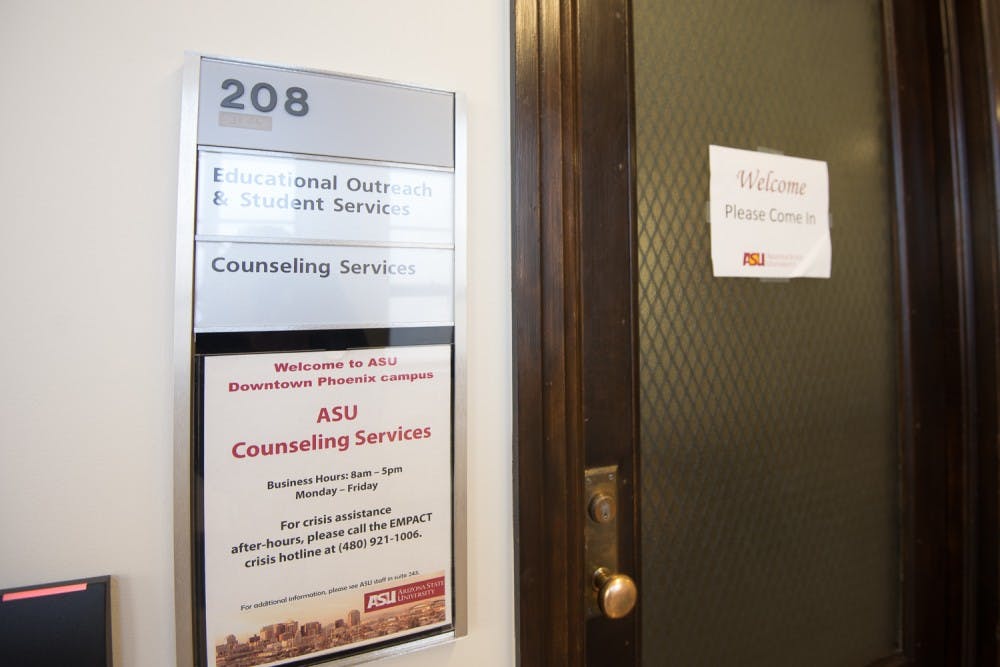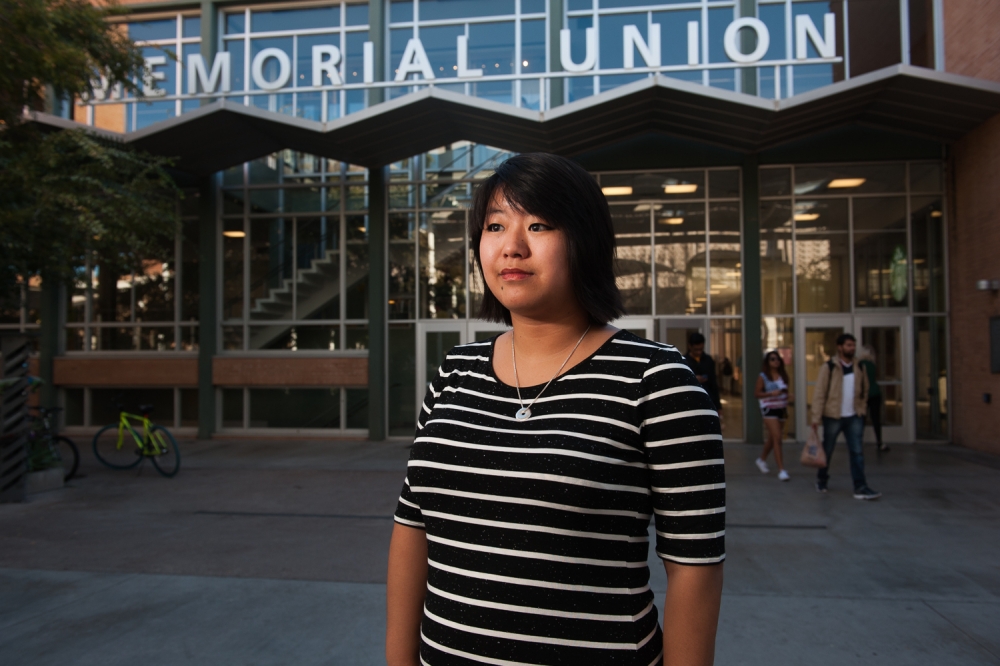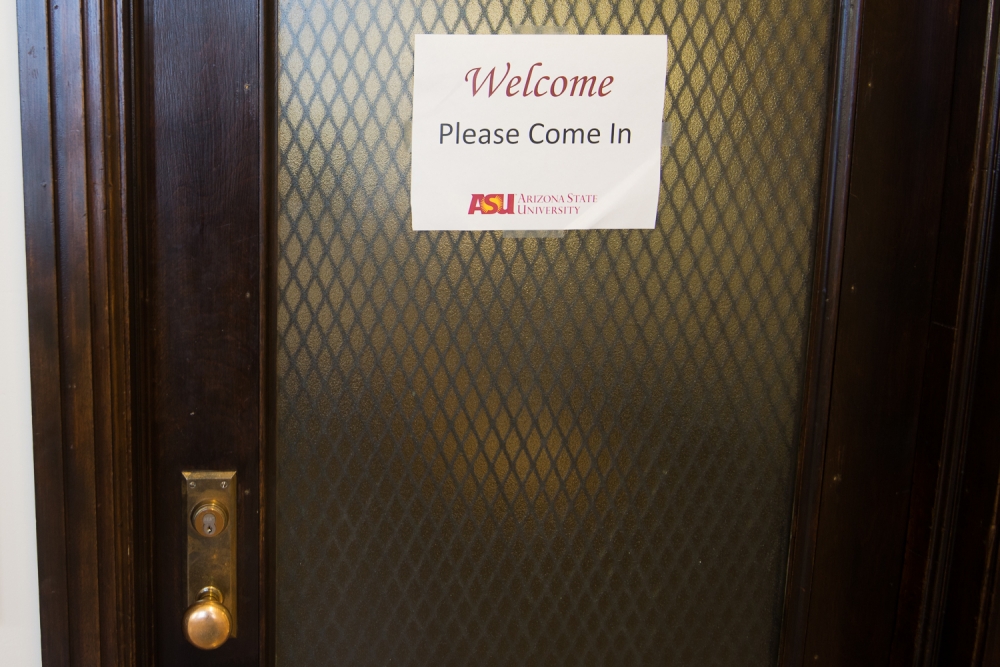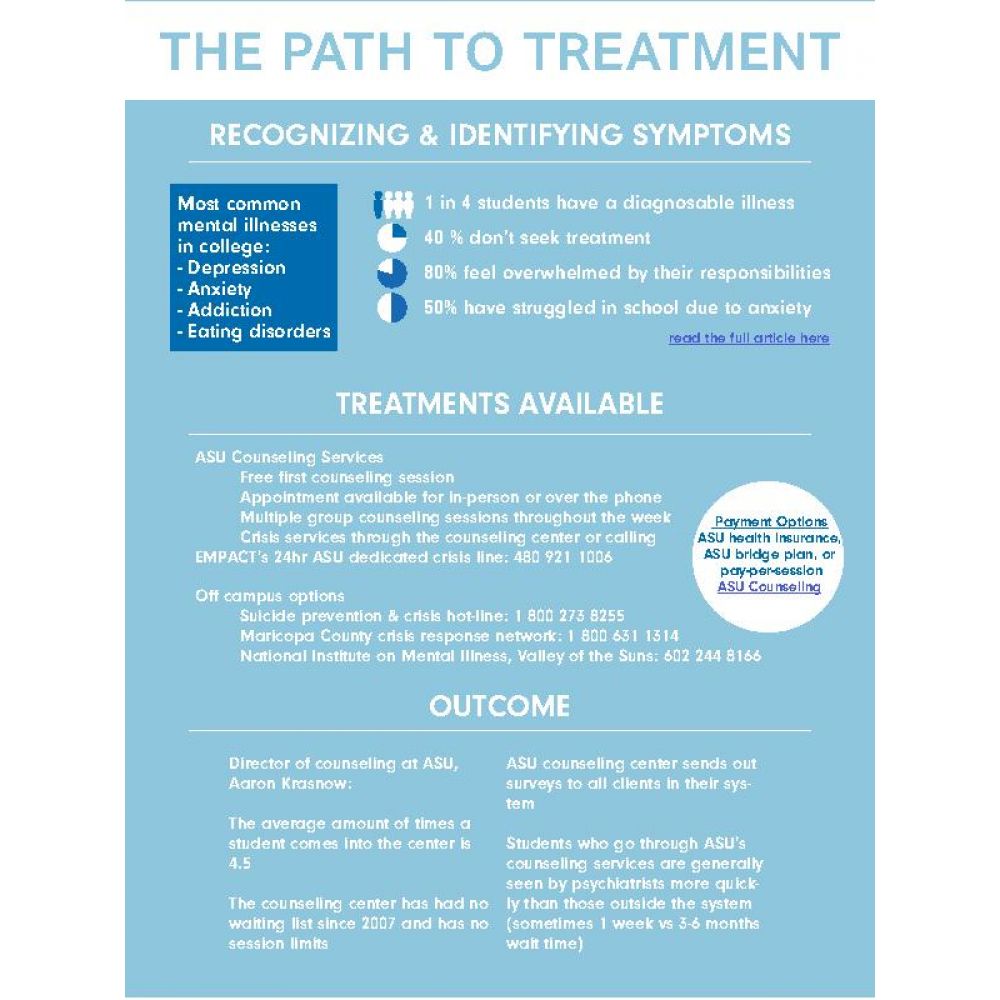In the global consciousness, mental health is like a door that is never more than slightly open. Even when a celebrity’s candidness about their mental illness or a widespread tragedy opens it up a bit, a negative stigma can easily force it shut for those who need help.
How many mentally ill young people are walking away because the door is hardly open enough for them to poke their head through it? More specifically, how are the services on ASU’s campuses combining to help a population of students that needs it?
Marisol Perez, associate psychology professor, wrote in an email that ASU’s participation in a spring 2015 National College Health Assessment showed that out of 1,937 students who completed the survey, 35 percent of students reported feeling so depressed it was difficult to function one or more times in the past 12 months, 9 percent of students reported seriously considering attempting suicide in the past 12 months and about 1 percent reported actually attempting suicide.
Read More: Mental health and you: facts and on-campus resources for ASU students
Biological sciences junior Liam O’Neill, president of campus-wide suicide-prevention organization Ask.Listen.Save, said the negative stigma surrounding mental health continues to leave problems undertreated and underrepresented. His organization strives to destigmatize and reach out to those struggling with a mental illness who are unable to speak about it.
The “asking” and “listening” parts of Ask.Listen.Save are reflected in O’Neill’s desire to see the conversation about mental health grow more on campus.
“Students can talk to other students in a different way than professionals can,” O’Neill said. "Conversation between two individuals on the same level is most effective way to combat any issues.”
The problem is, as hard as groups like Ask.Listen.Save may try, students still aren’t having enough of these conversations. The hope is that ASU’s counseling services would play a role in encouraging open conversation.
Collaborative counseling
Aaron Krasnow, associate vice president of counseling and health services, said the counseling center’s efforts can be summed up by a process he referred to as “collaborative decision making.”
“We don’t position ourselves as a place for therapy,” Krasnow said. “We position ourselves as a place for support. From that first appointment, we re-distribute it into our environment or into resources within ASU’s community. That’s the philosophy of collaborative decision-making.”
Read More: Adjusting to college can be hard, but resources exist to deal with stressors
Krasnow said the top three most frequent mental health symptoms seen by the center are anxiety, depression and adjustment difficulties, respectively. But the ability of students exhibiting these symptoms to be involved in this process of collaboration may be impaired by the fact that many are not fully aware of the resources offered by counseling services, or that on-campus counseling exists to the extent that it does at all.
Katherine, a senior, had a great deal of positive things to say about her experience with counseling services and the group therapy sessions offered, but expressed a deep desire to have more students be aware of those options.
Katherine attended a group therapy session on multiple occasions that explained coping methods, a process she found very helpful. She also said her one-on-one counseling appointments helped her find stability, and that she didn’t think many students were aware of those services and the benefits they could offer.
A student, who wished to remain anonymous because of the stigma surrounding mental health, also attended a similar group therapy session, wrote in an email that he appreciated the fact that group therapy existed, but wasn’t as fond of the structure as Katherine.
“It was cool to be in the same place as other students who have felt similarly,” he wrote in an email. “But the counseling representatives … lacked a bit of human touch.”
He wrote that the facilitators spoke a bit too quickly and technically, and that he didn’t like the lengthy packet of techniques they handed him.
“It could be a lot better if they took a more human approach to leading the group,” he added.
Krasnow said the center currently offers about a dozen different group therapy options, and forms new groups as students identify and express different needs.
Unfortunately, it is not only the group therapy that students feel is poorly advertised — it is the counseling center as a whole.
Making services known
Film and media studies alumnus Dakota Snider said the crisis and grief therapists at ASU’s counseling center were “some of the most incredible people” he had ever dealt with.
He began seeing a therapist after a fellow member of the ASU Outdoors Club, of which he was president at the time, died after a rappelling accident in spring 2015.
Snider said all members were offered free counseling services, and that the counselors were highly involved in the collective healing process, even attending the club’s candlelight vigil.
He suggested a couple of different steps ASU could take to advertise their counseling services more, including making freshmen more aware of the treatment options and advertising to other club leaders more, who could then reach out to members in need.
Read More: Barrett, the Honors College commits to bringing mental health awareness to ASU
However, Krasnow said the counseling center actually does take steps to make sure its services are widely advertised, including mentioning the center at orientations and move-in days and ensuring that the services are promoted by various academic units, offices and residence halls.
He said the counseling center actively trains people on how to bring up counseling services and talk about the issues that would necessitate the services’ use.
Many students agreed that these methods of advertisement remain insufficient, especially since some students, like journalism student Rose, do not come from an environment where so many wellness resources are available.
Rose said her experience with the counseling center came after someone broke into her dorm room and left her feeling violated. In spite of the stress, Rose said she was amazed at how quickly ASU’s support system stepped in and connected her with a counselor.
“I was in contact with a counselor for a good amount of time after that, and they were really understanding,” she said. “They reached out to me; I didn’t even have to do anything.”
That being said, she wholeheartedly agreed that counseling should be advertised more, saying she wasn’t aware the service existed prior to the incident.
Some students, on the other hand, don’t support ASU’s counseling services enough to promote them.
Gender studies senior Emma-Li Thompson said her one and only experience with counseling was her freshman year, during which time she met with a counselor who she said was “generally unhelpful” and offered her nothing more than temporary solutions to her deeper issues.
Thompson also expressed dissatisfaction at the fact that she came back to the counseling center the following semester to find her file had already been thrown out.
“I feel like they treated me like I was some temporary problem,” she said.
Staying accountable
Krasnow said the counseling center has several systems of self-evaluation to make sure they are kept accountable and remain as effective as possible.For example, the counseling center works with an Undergraduate Student Government health services advisory group to make sure students’ expressed mental health needs are met, and also produces bi-annual satisfaction surveys to evaluate the center’s operational and clinical health.
The surveys are handed out during appointments and only sent out to students whose information is in the center's system. Krasnow said the surveys address systemic technicalities such as staff.
“Upon arriving, the receptionist was rather rude and hurried with me. She looked perplexed as to why I was there, as opposed to my hope of a welcoming encounter,” one student said. “While I was filling out the forms, I could overhear the receptionist talk with the person I was scheduled to see about how I was late for my appointment, which was distracting.”
History alumna Amanda said her first and only appointment her freshman year was not all that helpful.
“It didn’t really help me at all or give me any coping mechanisms,” she said. “I wish they would have given me more resources for help and told me that what I was going through was common.”
Amanda said her counselor asked her a lot of questions and told her to come back, but she was never financially able to do so. While she said her first appointment fee was waived, she said she wasn’t able to pay the co-pays that additional appointments would have required.
Krasnow said that “no student’s financial circumstance will get in the way of their counseling.”
He said counselors always engage students in a conversation about future plans during their first appointment, including how to finance those plans.
Krasnow said the best options for a student looking to finance their counseling is to go through ASU’s health insurance, use the bridge plan or utilize a self-pay rate of $40 per session, which is consistent with standard community rates. The center also waives fees and cuts rates when necessary.
“If a student doesn’t reveal a concern about finances, we at least engage that conversation. We talk about anything that might get in the way of their treatment,” he said.
That focus on accessibility is a way the counseling center aspires to align itself with ASU's mission.
“If I were to put limits on our counseling center, not only do I not believe in the service model, but I would be a mismatch,” Krasnow said. “Because this University is about accessibility and high quality… (the counseling center) is always evolving to make sure we’re both accessible and high quality.”
Breaking the stigma at ASU
Still, most students agreed that the globally negative stigma surrounding mental health only makes the development of perfect counseling services more difficult. The key is in the conversation, and students suggested different ways the university can go about opening up that conversation.
Thompson said professors should be more open to discussions about mental health by noting services on their syllabi and understanding that some students’ academic concerns may be due to mental health issues outside of the classroom.
Journalism sophomore Izzy Greenblatt said she applauded the fact that many ASU community assistants take steps to inform their students of mental health services. She also said that ASU’s huge population makes it easy for students to meet friends who will help them talk through their struggles.
In spite of any shortcomings that may exist in the national or university system, ASU students seeking help for their mental health issues have many options. The conversation about mental health seems to slowly but surely be entering the collective consciousness of the University, even for ASU President Michael Crow.
Read More: Crow, administration explain role of ASU mental health services on campus
In an interview with the State Press Editorial Board, Crow vouched for the University’s system of partnering with outside psychiatric clinics and expressed commitment to creating satisfactory mental health services in light of recent nationwide campus shootings.
On a local and a national scale, even the strongest psychotherapeutic systems can’t be fully healthy if the conversation around mental health doesn’t get better.
For students like Amanda, a shift in the conversation is key to progress in the mental health paradigm at ASU. Only then can the door to a more efficient system of mental health treatment swing wide open.
“I just wish people would’ve told me how normal it was,” she said. “I thought I should just sort of handle it myself, but I wasn’t mature enough or stable enough to handle it. I wish someone had told me that what I was feeling wasn’t normal, and that I needed to get help. I wish they had said ‘this happens a lot at your age, but it’s going to be OK.’”
Editor's Note: If you're having trouble with any stress or depression, please contact ASU Counseling Services. You can call or walk into locations on any of the four campuses during the day or call ASU's EMPACT hotline after hours or on weekends at 480-921-1006.
Reach the reporter at celina.jimenez@asu.edu or follow @lina_lauren on Twitter.
Like The State Press on Facebook and follow @statepress on Twitter.







